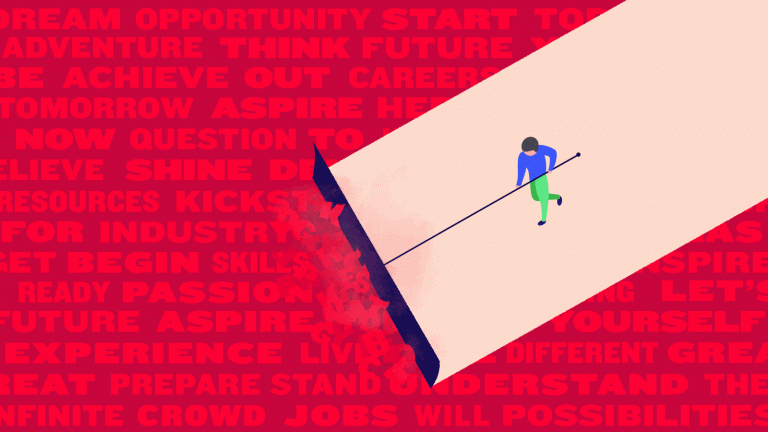As the new year rolls in, we set off to school or work (or both), with a lunchbox full of fresh ideas and perspectives on how to be bigger and better . For education brands, a new year brings opportunities to stand out from the sea of familiar faces and tell a different story. What might that be? Here are the trends we expect to see this year.
The following is an excerpt from ‘Selling the dream: Messaging trends in tertiary education’. Download the full version here.
Specialisation
Working to your strengths.
Institutions that offer a broad range of courses across multiple disciplines struggle to find a core differentiated message. You can’t be everything to everybody.
Rather than creating generalist high-level brand messaging as an attempt to catch all, institutes could place more effort on creating strategically focused faculty-level or specialisation sub-brands.
This would target areas of depth and strength, instead of averaging out their messaging to cover areas of weakness. Doing this would enable brands to calibrate messaging more finely to their desired market segment, with their own distinct voice and style that targets the hearts and minds of the right candidate, rather than every candidate.

Failure
The original incubator.
There is a strong trend towards innovation and entrepreneurship in tertiary education, both in application—the development of innovation districts, incubators and accelerators—and in marketing, as seen in the Think Differently themed campaigns. The tech and start-up sectors celebrate failure as an essential part of learning. Can tertiary education fully embrace this notion as well? Will the term ‘failure’ become less taboo in marketing vernacular? Will learning brands—traditional in their approach to brand and marketing—be bold enough to go there?
After all, what are tertiary education institutes if not places to fail safely?

Tribes and belonging
Where does belonging belong?
Although young people are saying that they value relationships and consider them a greater measure of success than their work or career, there is notable absence of love & belongingness—personal relationships—in the messaging when viewed through the lens of Maslow’s Hierarchy of Needs drivers. Are individuals looking for more than just a pathway to work from in their tertiary education experience? Should belonging to a community or a tribe play a greater role in messaging? Tribes are nothing new. Throughout history people have come together under a shared set of values, beliefs or emotions. Often polarising in their shared set of views, this differentiation from others attracts passionate followers and creates believers.

Today it could be said that people express their identity and signal their unique set of values via the brands they choose to follow, share and subscribe to. Brands in other sectors have successfully tapped into this basic behavioural instinct of ‘belonging’ and have used it to their full advantage, building lifelong customers who rally around their same set of values, emotions and beliefs. Creating a sense of belonging leads to brand loyalty and advocacy. Combined with the continuing fragmentation of ‘real-world’ communities, we expect there to be more emphasis on belonging to a community or tribe of like-minded individuals around tertiary education brands—especially for bricks-and-mortar institutions.
Experience
From customer-centric to human-centred.
If young people value success in their personal life more than in their professional life, as research showed, why isn’t messaging more geared towards this mindset? Should messages of happiness, support for mental health, and stability and promises of positive relationships feature more than getting a job? Can this be delivered through a better educational experience? Designing better experiences means being empathetic to the needs and wants of the humans at the centre of the experience—the practice of human centred design. Asking the question: How can we make their lives easier? Better?

Following trends in other sectors towards better customer experiences and service design, we anticipate more emphasis will be put on the holistic education experience as a key point of brand differentiation. This will become increasingly important as a less linear, more tailored approach to the individual’s personal learning journey continues to emerge. Creating better user experiences overlaps with establishing tribes. Designing better ways that allow people to connect and belong enables them to feel like they are part of something bigger and richer—something more than a business-like transitional stage between secondary education and employment. This is particularly relevant for bricks-and-mortar providers, which have a clear advantage over online-only learning due to their physical nature. It’s much easier to make authentic connections and better experiences in person than in isolation over the internet.
A lifetime of learning
Tertiary education. Not just for young people.
Although our audit showed that the majority of brand and campaign messaging is directed at young people, there is a much greater opportunity to widen the scope of the target market.
Education is no longer just the stage you go through before you get into the ‘real-world’ of work, it’s a lifelong pursuit. It’s now predicted that the average 15 year old will have 17 jobs across five different careers throughout their lifetime, with each new job and career requiring new skills, knowledge or training. As the idea of a lifetime of learning begins to take hold, the role that tertiary education brands play in the life of individuals is changing. There are opportunities to think more about the long game—to build long-term relationships and emotional connections through better engagement, and to retain students for much longer than just a three-year course.
Providers have an opportunity to better engage mature students and bring them back into the fold, while becoming a learning partner for those about to embark on the journey.

—
Aspirational generalism just won’t cut it anymore. All brands have their own unique story. It’s time to rediscover, redesign and reconnect.
The ‘Selling the dream‘ report uncovers the trends in marketing messages in tertiary education and explores the meaning and emotions behind the messages. We explore:
-
- Who is the audience? What do they think and feel about life and the future? What do they want from education and work?
-
- What are the messages and the meanings behind these marketing messages? What emotional and psychological levers are brands pulling to influence choice?
-
- How do these messages compare to what individuals really want?
-
- What are the challenges for the sector?


